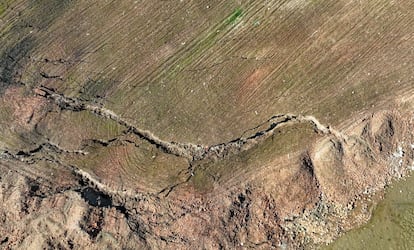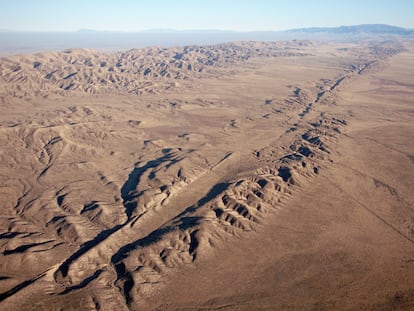Turkey earthquakes displaced the Earth’s crust by hundreds of miles
The two tremors shifted the entire Anatolian plate to the west, a phenomenon that necessitates a reevaluation of existing seismicity models

The earthquakes that struck southeastern Turkey in the early hours of February 6, 2023, followed by a second one at noon the next day, have prompted scientists to reevaluate what they know about seismology. According to research published in Science on Thursday, these two earthquakes displaced the Earth’s crust hundreds of miles from their epicenters, affecting not only the friction zone but also shifting the entire Anatolian plate westward. Though the movement was just one centimeter (0.4 inches), this represents nearly half of the plate’s average annual drift. For seismologists, the events have exceeded what could have been expected based on the existing models used to predict seismic risk.
Turkey is particularly vulnerable to earthquakes, sitting atop the Anatolian plate, surrounded by the Eurasian plate to the north, the Arabian and African plates to the south, and the Eurasian and Aegean plates to the west. The Earth’s crust, which floats on the mantle, is divided into several tectonic plates that either diverge, converge, or slide past one another, which is what causes earthquakes. They tend to happen along fault lines at plate boundaries. The February earthquakes took place along the East Anatolian Fault. Despite Turkey’s long and tragic history with earthquakes, there hadn’t been major seismic events along this fault line or in the southeast for over a century. Most recent disasters occurred near the convergence with the Eurasian plate.
The long period of relative calm likely allowed pressure to build up in the area, which could explain the immense power of the 2023 quakes, one measuring 7.8 and the other 7.5 in magnitude. The impact was catastrophic, with nearly 60,000 people killed, countless more injured, and widespread destruction of infrastructure. However, what has surprised scientists most is how much farther these two earthquakes have displaced the Earth’s crust.
“Normally, we can model the displacements associated with an earthquake using elastic models that account for the Earth’s curvature and the geometry of the fault,” says Philippe Vernant, a geologist at the University of Montpellier and co-author of the Science study. “What’s surprising about this earthquake sequence is that the far-field displacements observed on the Anatolian plate are too high.”
Seismicity maps are based on isolated earthquakes, but what we see is that this is not the case: past events are interconnected with future ones, either accelerating or delaying subsequent earthquakesJulián García Mayordomo, Spain’s Geological and Mining Institute
Vernant and his colleagues relied on data from a network of GNSS sensors (ground-based geolocation systems) that use three major satellite constellations: the American GPS, European Galileo, and Russian Glonass. They detected that the Earth’s crust shifted as far as 700 kilometers (about 435 miles) from the epicenters of the earthquakes. This is beyond the range of traditional seismicity models, which typically track the waves originating at the epicenter. The recent use of GNSS systems in seismology allows scientists to detect changes in the elevation and position of terrain around the epicenter. A recent study that used data from thousands of GPS devices even suggested that large earthquakes could be anticipated.
The second significant finding is that this displacement was not confined to the fault zone, which is typically expected during an earthquake. Instead, the entire Anatolian plate shifted one centimeter (0.4 inches) to the west. “A centimeter is not much compared to the four to five meters [13 to 16 feet] of slip on the fault. But one centimeter in a place where no displacement should have been observed is very substantial,” explains Vernant, an expert in faults and seismic activity.
Adding to the complexity, the Arabian plate — which forms the southern section of the fault where the earthquakes occurred — showed no perceptible distant displacement, despite being the area where much of the destruction and loss of life occurred, especially in Syria. “The Anatolian plate moved more than expected, while the Arabian plate barely moved,” Vernant notes. As a result, Asia Minor is being stretched and pulled toward the Aegean plate, rather than being pushed by the Arabian plate.
“I always find myself surprised when I compare this to geopolitics: no matter what the Europeans do, Anatolia is being pulled towards Europe at a rate of about 24 millimeters a year,” Vernant jokes.
Juan Soto, a professor of structural geology and tectonics at the University of Texas in Austin, emphasizes that the westward movement of the Anatolian plate toward the subduction zone of the Hellenic arc was already known. “What’s novel about this study is that it analyzes, using satellite data, how all the deformation has been distributed on the surface. Almost everything was known about the two large earthquakes last year — how they were generated, how the deformation was distributed along the faults, the origin of the earthquakes — but what is new here is that they found that not only did the deformation extend along the faults, but also that it affected the interior of the plates,” he explains.
Soto highlights that one of the study’s major contributions is its finding that the entire plate undergoes deformation and accumulates energy, which is then released during large earthquakes. “This doesn’t occur with every fault or every earthquake,” he notes. “These are earthquakes that generate a tremendous amount of energy. This energy is dispersed, distributed and causes other areas of the plate to shift and continue breaking.”

This research opens the door to a troubling possibility: earthquakes on the southern fault could destabilize the already precarious northern fault, which has been responsible for most of the earthquakes in Asia Minor over the past century. Philippe Vernant notes: “The average annual displacement of the plate is 24 mm per year westward relative to the Eurasian plate. How this impacts the timeline for the next earthquake in the Marmara Sea [northwest of the Anatolian plate], whether advancing or delaying it, remains a mystery.”
Julián García Mayordomo, an expert in earthquake geology at Spain’s Geological and Mining Institute (IGME), points out that “no movement occurs hundreds of kilometers away — or at least it shouldn’t.” This “shouldn’t” is what makes the findings of the two earthquakes in Turkey in 2023 so significant. “Traditional models fail to explain such large displacements so far away,” he adds.
According to García Mayordomo, one of the major contributions of this study is the understanding that “what happened from 20 years ago can influence future seismic activity, though we still don’t know how.” He continues: “Seismicity maps are based on isolated earthquakes, but what we see is that this is not the case: past events are interconnected with future ones, either accelerating or delaying subsequent earthquakes.”
Sign up for our weekly newsletter to get more English-language news coverage from EL PAÍS USA Edition
Tu suscripción se está usando en otro dispositivo
¿Quieres añadir otro usuario a tu suscripción?
Si continúas leyendo en este dispositivo, no se podrá leer en el otro.
FlechaTu suscripción se está usando en otro dispositivo y solo puedes acceder a EL PAÍS desde un dispositivo a la vez.
Si quieres compartir tu cuenta, cambia tu suscripción a la modalidad Premium, así podrás añadir otro usuario. Cada uno accederá con su propia cuenta de email, lo que os permitirá personalizar vuestra experiencia en EL PAÍS.
¿Tienes una suscripción de empresa? Accede aquí para contratar más cuentas.
En el caso de no saber quién está usando tu cuenta, te recomendamos cambiar tu contraseña aquí.
Si decides continuar compartiendo tu cuenta, este mensaje se mostrará en tu dispositivo y en el de la otra persona que está usando tu cuenta de forma indefinida, afectando a tu experiencia de lectura. Puedes consultar aquí los términos y condiciones de la suscripción digital.
More information
Archived In
Últimas noticias
Most viewed
- Reinhard Genzel, Nobel laureate in physics: ‘One-minute videos will never give you the truth’
- Pablo Escobar’s hippos: A serious environmental problem, 40 years on
- Charles Dubouloz, mountaineering star, retires at 36 with a farewell tour inspired by Walter Bonatti
- Why we lost the habit of sleeping in two segments and how that changed our sense of time
- The fall of a prolific science journal exposes the billion-dollar profits of scientific publishing











































